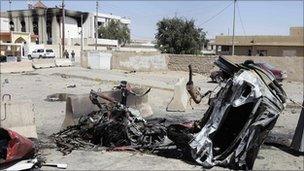Iraq blames al-Qaeda for Tikrit attack
- Published

Sunni militants linked to al-Qaeda were responsible for a bloody siege in Tikrit in which 56 people were killed, Iraqi officials have said.
Tuesday's attack took place at a local government building in Tikrit, the hometown of Saddam Hussein.
A fierce gun-battle ended when the attackers - numbering about eight - blew themselves up.
Among the dead were local government officials and an Iraqi journalist. Another 100 people were injured.
Tikrit - the capital of Salahuddin province - was once a stronghold of the Sunni insurgency which followed the American-led invasion of 2003.
'Ruthless' attack
The attack began at 1300 local time (1000 GMT) and lasted for more than four hours.
Gunmen wearing military uniforms over explosives belts blew up a car outside the council headquarters to create a diversion.
Then they charged into the building and shot more than a dozen people, including three lawmakers who were killed by a single gunshot to the head.
The standoff ended only when the attackers blew themselves up in what was one of the bloodiest days in Iraq this year.
Shortly afterwards, a curfew was imposed in Tikrit, about 160km (100 miles) north-west of Baghdad.
Salahuddin Governor Ahmed Abdullah called the attack "a tragic incident carried out by ruthless terrorists".
Iraqi officials were quick to blame al-Qaeda for the attack, noting that execution-style killings and suicide bombings are hallmarks of the group.
An intelligence official in Baghdad likened the attack to al-Qaeda's hostage raid on a Catholic church in Baghdad last October that left some 60 people dead, the AP news agency reported.
Violence across Iraq has declined substantially since its peak in 2006 and 2007, but attacks remain common.